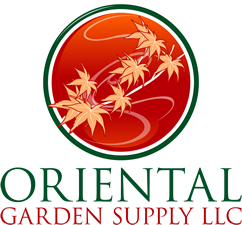


|

|
|
Planting InformationHere at Oriental Garden Supply, we are often asked about the best way to choose plants and how to put them in the ground properly, so we’ve come up with some general guidelines to help you along. LOCATION, LOCATION, LOCATION: Different plants have different requirements to insure they thrive in your garden landscape. Knowing the plant’s optimal sun exposure, moisture levels and soil conditions will go a long way to help them look great. The descriptions on our plant tags are helpful and we’re always happy to talk to you directly to help you select the right plants for your location.
DIGGING IN: Planting depth: A sure way to stress many plants is to plant them too deeply. Roots flare out from the main stem or trunk of a plant – locate this flare and plant the roots just under the soil surface. Plants need oxygen to thrive and planting too deeply can deny this need. Too deep planting may also rot the bark and underlying cambium layer needed to transport nutrients to and from the leaves. Container plants: Sometimes a container-grown plant may have roots that are circling inside of the pot. If you take a plant out of its pot and the roots are so dense that they still hold the shape of the pot, you should loosen them carefully allowing them to work their way into the new soil. Some root masses may be tight, so don’t be afraid to really work them apart, even giving them a little trim if needed, before putting the plant in the ground. The plant will strangle itself and die if the roots continue to grow in this “root cage.” Also, be sure to find the root flare as above and plant accordingly. Ball & Burlap Plants: When you buy a larger plant with a burlap-wrapped root ball, you want to leave the burlap on when you plant it - it will rot away once it’s in the ground. Planting depth is important for these plants too. We recommend setting the plant a bit high in the hole, maybe 2-3” above ground level. Tuck in the surrounding soil, then cut the cord wrapped around the trunk only and peel back the burlap. You may cut away this top burlap or simply leave it under any mulch you may apply. After you have peeled back this top burlap, gently dig into the soil to find the root flare of the plant and make sure it is close to the intended soil surface. If it is too deep, you may remove some of the surrounding soil on the root ball. In the worst case, you may have to raise the tree a bit so it does not sit too low in the planting hole. Critters: Mice, voles, rabbits, woodchucks, and deer can be quite destructive to the landscape and sometimes just proper placement or selection can solve the problem. There are many plants at OGS that are “critter resistant”, meaning that they are generally not tasty to many animals. There are also commercially available products that you can spray on or distribute on the ground near plants that will deter them. And sometimes, you just can’t use a certain plant because of its extreme attractiveness to hungry critters. Ask us if you need any advice. T.L.C. Mulching: Mulch helps retain moisture in your soil and can provide a decorative weed barrier to set off your plants attractively. However, mulch against the trunk of a tree may cause it to rot. Think of building a moat around the base of your plant to collect and conserve water. A mulch volcano (piling mulch up on the trunk) is destructive. We generally recommend pine bark mulch, which will put nutrients back into the soil as it decomposes, and not hardwood mulch, which removes nitrogen – a fertilizer - from your soil to help it decompose. Care after planting: Not surprisingly, new plants need attention. The first year is especially critical. Plants are putting out new roots and establishing themselves. If the weather is dry, extra water will be needed. If it’s an especially wet season, check to see that your site is not collecting and retaining water. Make sure that the plant goes into winter with moist feet. Fall drought, even after the leaves have dropped, can damage a plant, even well-established plants. After the first year, it is still important during periods of extended drought, even though the plant may look fine, to keep it watered to avoid stress that may not show until the following year or even later. We have seen plants established for 10 years not wake up after a bad drought year, even though it looked fine all season. A FINAL WORD: Most plants, if planted correctly, given a moist well-drained soil, morning to early afternoon sun, protection from the worst of the cold dry winter winds, and kept free of critters, will do well. Experimenting with alternatives can be fun, but costly in many cases. Protect your investment by doing your research, paying attention to conditions throughout the seasons, and your plants will provide a great deal of joy and beauty for many years to come! 448 West Bloomfield Road Pittsford, NY 14534 |